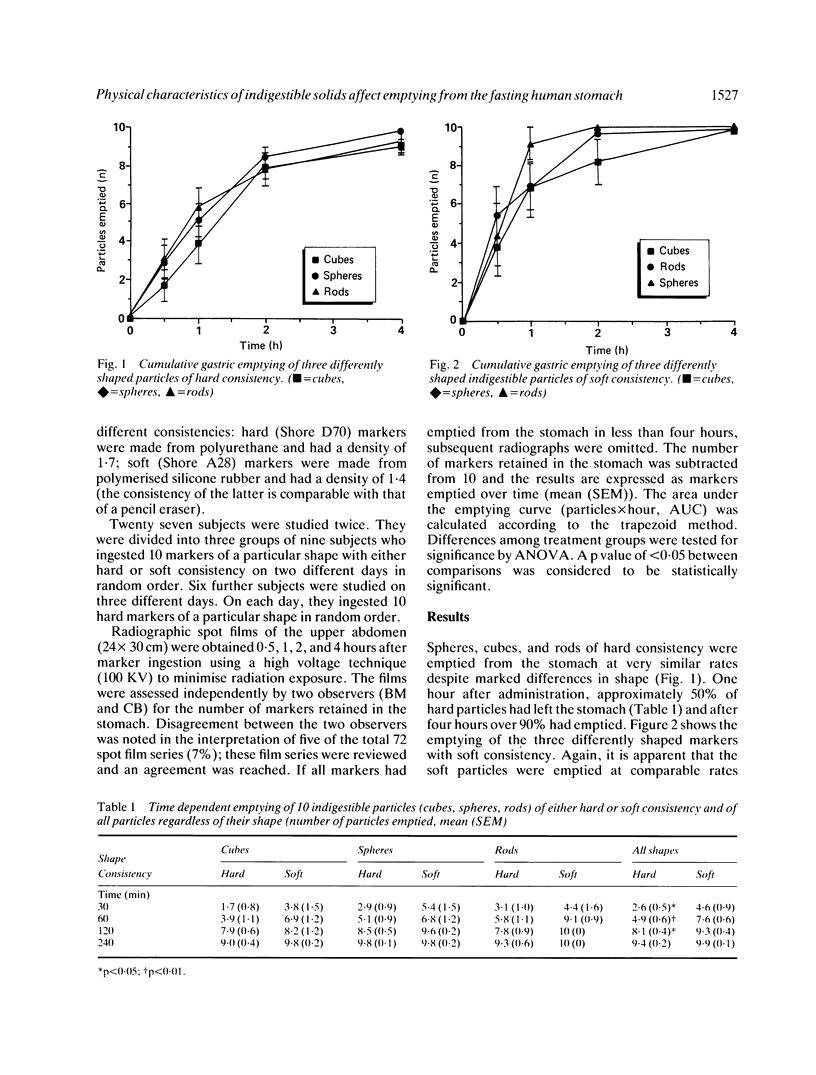Abstract
Gastric emptying of indigestible solids depends on their size. It is not clear whether physical characteristics other than particle size affect emptying of indigestible solids from the fasting human stomach. We studied gastric emptying of three differently shaped particles, (cubes, spheres, rods) of either hard or soft consistency during the fasting state in human volunteers. The shape of indigestible particles did not affect their emptying. The area under the gastric emptying curve (AUC: particles x hour) was for hard cubes 24.7 (2.2), for hard spheres 27.9 (1.6), for hard rods 26.9 (2.7). All soft particles emptied faster than their identically shaped hard counterparts, but there was no difference among the three shapes (AUC for soft cubes: 29.2 (3.0), for soft spheres 32.0 (1.8), for soft rods 34.1 (1.2). If gastric emptying of hard and soft particles was compared independently of their shape, soft particles emptied significantly faster than hard ones: AUC 31.8 (1.2) v 26.5 (1.3) (p less than 0.01). In conclusion, the consistency but not the shape significantly affects gastric emptying. Specific physical characteristics other than size and shape may affect gastric emptying of indigestible particles which may be of importance in the design of drugs.
Full text
PDF



Selected References
These references are in PubMed. This may not be the complete list of references from this article.
- Davis S. S., Hardy J. G., Fara J. W. Transit of pharmaceutical dosage forms through the small intestine. Gut. 1986 Aug;27(8):886–892. doi: 10.1136/gut.27.8.886. [DOI] [PMC free article] [PubMed] [Google Scholar]
- Feldman M., Smith H. J., Simon T. R. Gastric emptying of solid radiopaque markers: studies in healthy subjects and diabetic patients. Gastroenterology. 1984 Oct;87(4):895–902. [PubMed] [Google Scholar]
- Holt S., Reid J., Taylor T. V., Tothill P., Heading R. C. Gastric emptying of solids in man. Gut. 1982 Apr;23(4):292–296. doi: 10.1136/gut.23.4.292. [DOI] [PMC free article] [PubMed] [Google Scholar]
- Houghton L. A., Hickson F., Read N. W. Effect of food consistency on gastric emptying in man. Gut. 1987 Dec;28(12):1584–1588. doi: 10.1136/gut.28.12.1584. [DOI] [PMC free article] [PubMed] [Google Scholar]
- Meyer J. H., Dressman J., Fink A., Amidon G. Effect of size and density on canine gastric emptying of nondigestible solids. Gastroenterology. 1985 Oct;89(4):805–813. doi: 10.1016/0016-5085(85)90576-1. [DOI] [PubMed] [Google Scholar]
- Meyer J. H., Ohashi H., Jehn D., Thomson J. B. Size of liver particles emptied from the human stomach. Gastroenterology. 1981 Jun;80(6):1489–1496. [PubMed] [Google Scholar]
- Minami H., McCallum R. W. The physiology and pathophysiology of gastric emptying in humans. Gastroenterology. 1984 Jun;86(6):1592–1610. [PubMed] [Google Scholar]
- Smith H. J., Feldman M. Influence of food and marker length on gastric emptying of indigestible radiopaque markers in healthy humans. Gastroenterology. 1986 Dec;91(6):1452–1455. doi: 10.1016/0016-5085(86)90200-3. [DOI] [PubMed] [Google Scholar]
- Spiller R. C. Where do all the tablets go in 1986? Gut. 1986 Aug;27(8):879–885. doi: 10.1136/gut.27.8.879. [DOI] [PMC free article] [PubMed] [Google Scholar]


